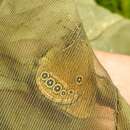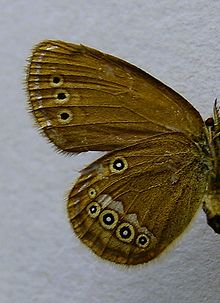en
names in breadcrumbs


The False Ringlet is a very local species that is declining at an alarming rate in several countries, though more stable in others. It inhabits low-lying, grassy marshes and reed-beds that are usually situated in the shelter of woodland, creating a warm and humid environment, but also in overgrown dry grasslands in the southern part of its range. The butterflies fly very slowly and hardly ever colonize nearby habitats. The eggs are deposited one by one on the blades of grasses, like meadow-grasses (Poa spp.), rye-grasses (Lolium spp.), hair-grasses (Deschampsia spp.), sedges (Carex spp.) and Purple Moor-grass (Molinea caerulea). The caterpillars hibernate half-grown in the tussock, where they pupate as well. The False Ringlet has one generation a year in June or July depending on altitude. Habitats: humid grasslands and tall herb communities (26%), blanket bogs (20%), raised bogs (13%), fens, transition mires and springs (10%), mixed woodland (6%), broad-leaved deciduous forests (6%), water-fringe vegetation (6%).
Coenonympha oedippus, the false ringlet, is a species of butterfly in the subfamily Satyrinae.[2] It is found in Austria, Belgium, the Netherlands, France, Hungary, Italy, Japan, Kazakhstan, Liechtenstein, Mongolia, Poland, Russia, Slovakia, Slovenia, Spain, Switzerland, and Ukraine. It is extirpated from Bulgaria, Germany, and Slovakia.
C. oedippus F. (= oedipus O., geticus Esp., pylarge Hbn.) (48 a). Without markings on the upper-side, dark sooty brown. Underside rusty brown washed with yellow; on the hindwing one ocellus before the apex and a straight row of pale-edged ocelli before the distal margin. In Central Europe, very sporadic, in Belgium, France, Northern Italy, Austria, Hungary; in Southern Russia and the Ural Mts. ab. miris F. has on the underside of the forewing an increased number of enlarged ocelli ; among the nymotypical form. amurensis Rühl [ Heyne] (48 a) is considerably larger, on the upperside especially dark-coloured, with a very distinct metallic line on the underside; from Eastern Siberia, particularly Amurland. — annulifer Btlr. (48a) is still larger, the ocelli on the underside strongly enlarged, sometimes elongated transversely; Japan. Larva pale green with a dark dorsal line and light lateral stripe ; head dark olive-green. From July until May on reeds (said to feed also on Iris). Pupa yellowish green with the capital processes brownish and the wing-cases yellowish with pale borders. The butterflies are on the wing in June and July ; they have a hopping flight and are found in damp meadows, especially such as are occasionally flooded. There they prefer stony hillocks. They are generally not numerous in their flight places and the latter are not always accessible because often situated in swamps.[3]
The false ringlet is endangered and is extirpated from some lands.
For more information on status and biology
Named in the Classical tradition.Oedipus is a king of Thebes in Greek mythology.
 Underside of a female
Underside of a female Coenonympha oedippus, the false ringlet, is a species of butterfly in the subfamily Satyrinae. It is found in Austria, Belgium, the Netherlands, France, Hungary, Italy, Japan, Kazakhstan, Liechtenstein, Mongolia, Poland, Russia, Slovakia, Slovenia, Spain, Switzerland, and Ukraine. It is extirpated from Bulgaria, Germany, and Slovakia.